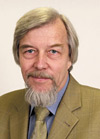Director's Corner
7 December 2006
 Barry Barish |
Parameters for the Linear Collider – An Update
As we explore the possible trade-offs to make the ILC Reference Design as cost effective as possible, we have needed sharper definitions for some of the stated parameters, making us consider alternatives. With this in mind, the International Linear Collider Steering Committee (ILCSC) reconvened their parameters subcommittee who wrote the original parameters report that dictates the scientific requirements and hence the design for the ILC. In August, I wrote about this ILCSC action, gave the motivation and charge to the committee, and anticipated that a parameters update would be the result. The parameters subcommittee has now issued its update. This revised document is very timely for us as we take the final decisions before freezing the Reference Design Report.
 Rolf-Dieter Heuer, chair of the ILCSC Linear Collider Parameters Subcommittee |
The ILCSC parameters subcommittee is global in nature, having members from Asia (Sachio Komamiya and Dongchul Son), from Europe (Rolf Heuer (chair) and Francois Richard) and from the Americas (Paul Grannis and Mark Oreglia). Overall, the updated report is consistent with the original and contains some clarifications, but no major changes. From our side, the Reference Design Report (RDR) that we are producing is consistent with this parameters report.
The update reaffirms that the baseline maximum centre-of-mass energy should be 500 GeV. In addition, it provides some necessary guidance to clarify exactly what that implies for the machine design. In particular the report states that "removing safety margins in the energy reach is acceptable but should be recoverable without extra construction. The maximum luminosity is not needed at the top energy (500 GeV), however, 500 GeV should be reachable assuming nominal gradient." We are in the process of analysing what margin to provide in the RDR, but in any case, we intend to follow the key point in this recommendation -- allow for the provision of full luminosity at the top energy. This means extra un-instrumented tunnel length, providing the margin needed, will be incorporated into the baseline.
The update also reaffirms the luminosity requirement: an integrated luminosity of 500 fb-1 should be achieved in the first four years of running after one year of commissioning. Recognising that full luminosity will not be achievable or required in the beginning, the Parameters Subcommittee concludes: "If absolutely necessary, it would be acceptable to run in the first year with fewer than the full number of klystrons and ramp up to the full complement by approximately year 4 of physics running," and that, if physics results motivate full luminosity, acquiring the full complement of klystrons should be given priority over operating the machine. We have considered initially halving the RF power, and consequently reducing the initial luminosity, but have not instituted this change.
Clearly maintaining the two most fundamental parameters -- energy and luminosity -- is of highest priority in developing the machine design. The other very important statements made in the updated report regard the detectors. First, it reaffirms that "the interaction region (IR) should allow for two experiments. Two experiments are desired to allow independent and complementary measurements of critical parameters and to provide better use of the beams thereby maximizing the physics output." All our efforts in designing the beams and interaction regions, as well as trade-offs we are considering, assume that we will provide for two detectors.
We have already instituted several changes in the beam delivery system and interaction regions due to cost considerations:
- We changed from two beams, 2 mrad and 20 mrad crossing angles, to two beams, both at 14 mrad;
- we have moved detector assembly to the surface, reducing the required hall size and significantly helping scheduling issues;
- we have reduced the muon shield, but retained the provision for adding more shielding.
Finally, we are considering the merits of removing one beamline and alternating detectors using the same shared interaction point, a so-called push-pull system. The technical feasibility of this system has been studied over the past couple of months. From these studies, the option appears promising and this change is being considered by the GDE Change Control Board. A decision has not yet been reached, nevertheless, anticipating that this option would be considered, the parameters update document states: "Switching between experiments should be accomplished with less than a few percent loss of integrated luminosity. If necessary for design and cost considerations, the two experiments could share a common IR, provided that the detector changeover can be accomplished in approximately 1 week."
We have instituted several other changes in the ILC baseline as part of our efforts to optimise cost to performance, but the majority does not affect the physics parameters. Also, several other parameter updates are addressed in this new document, and we believe our Reference Design remains consistent with both the original parameters document and the updated version. Finally, on behalf of the GDE, I want to thank the ILCSC and the Parameters Subcommittee for updating this important report.
-- Barry Barish